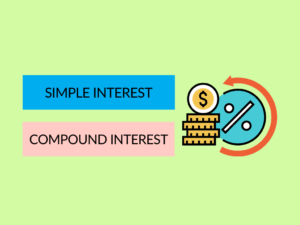Compound Interest vs Simple Interest
Managing your finances wisely requires understanding the concepts of interest. Two commonly used types of interest are compound interest and simple interest. While both play vital roles in various financial transactions, they differ in the way they are calculated and the impact they have over time.
What is Compound Interest?
Compound interest is the interest calculated not only on the initial principal amount but also on the accumulated interest of previous periods. In simple terms, it means earning interest on both your initial investment and the interest that has already been earned.
Examples of Compound Interest:
Let’s consider two scenarios where compound interest is involved:
- You invest $1,000 in a savings account with an interest rate of 5% per year. After the first year, you will have $1,050 ($1,000 principal plus $50 interest). However, in the second year, you will not earn 5% interest on the initial $1,000 only; you will earn it on the total amount of $1,050.
- A long-term investment, such as a retirement account or bond, where interest is compounded annually, quarterly, or monthly. The compounding frequencies determine the speed at which your investment grows over time.
Uses of Compound Interest:
Compound interest is commonly used in various financial aspects, including:
- Savings accounts
- Investments
- Mortgages
- Debt consolidation
- Loan repayments
What is Simple Interest?
Simple interest is a basic and straightforward method of calculating interest. It is calculated only on the principal amount (initial investment) for a specific period of time. Unlike compound interest, it does not take into account any previously accumulated interest.
Examples of Simple Interest:
Let’s consider two examples that illustrate the calculation of simple interest:
- You lend a friend $500 at an annual interest rate of 7%. At the end of the year, your friend will owe you $535.
- A short-term loan, such as a payday loan, where interest is calculated based solely on the initial principal amount for the duration of the loan.
Uses of Simple Interest:
Simple interest is commonly used in the following scenarios:
- Personal loans
- Auto loans
- Short-term loans
- Business loans
- Credit cards (if paid in full each month)
Differences Between Compound Interest and Simple Interest
| Difference Area | Compound Interest | Simple Interest |
|---|---|---|
| Calculation | Based on both the initial principal and accumulated interest | Based on the initial principal amount only |
| Formula | A = P(1 + r/n)^(nt) | A = P(1 + rt) |
| Frequency of interest updates | Can be compounded annually, quarterly, monthly, daily, etc. | Does not compound; remains the same throughout the duration |
| Growth over time | Exponential growth due to interest on interest | Linear growth |
| Effect on investments | Compound interest helps investments grow faster | Simple interest does not accelerate investment growth as much as compound interest |
| Loan repayments | Compound interest results in higher overall repayment amounts | Simple interest leads to lower total repayment amounts |
| Financial products | Savings accounts, bonds, long-term investments | Short-term loans, credit cards, personal loans |
| Usage in mortgages | Commonly used in mortgages to calculate interest payments and total repayment amounts | Not typically used in mortgages; simple interest would not be favorable for borrowers |
| Complexity | More complex to calculate and understand | Simple and straightforward to calculate and understand |
Conclusion:
In summary, compound interest takes into account the initial principal as well as accumulated interest, resulting in exponential growth over time. On the other hand, simple interest only considers the initial principal, leading to linear growth. The choice between compound interest and simple interest depends on the context and purpose, such as investments, loans, or savings goals.
People Also Ask:
- What is the main difference between compound interest and simple interest?
- Which type of interest is better for long-term investments?
- Are there any financial products that use simple interest?
- Can compound interest be applied to loans?
- Which type of interest should I choose for my savings account?
Compound interest is calculated on both the initial principal amount and the accumulated interest, while simple interest is calculated only on the initial principal amount.
Compound interest is better for long-term investments as it allows your money to grow faster due to interest on interest.
Yes, short-term loans, credit cards, and personal loans typically use simple interest in their calculations.
Yes, compound interest can be used for some loans, such as mortgages, resulting in higher overall repayment amounts.
Compound interest is generally better for savings accounts as it allows your money to grow faster over time.


